If you’re eager to explore the world of e-commerce and wondering how to dropship on Shopify, you’ve come to the right place. Starting an online business with minimal costs and inventory management is easy with Shopify dropshipping.
In this comprehensive guide, we’ll explore dropshipping on Shopify, offering a step-by-step roadmap for launching and growing your online business. We’ll cover Shopify, the dropshipping model’s benefits, and dive into key steps: niche selection, store setup, supplier sourcing, product addition, and effective management. You’ll also find essential tips and FAQs to boost your dropshipping confidence. Ready to start your e-commerce journey? Let’s begin…
What is Shopify?
Shopify is a widely used platform that simplifies the creation and management of online stores for individuals and businesses. It provides a user-friendly interface, seamless integrations, and a range of features to help entrepreneurs sell products online.
What is the dropshipping business model?
- Dropshipping is a business model where you, as the seller, don’t need to carry inventory.
- Instead, you partner with suppliers who fulfill the orders on your behalf.
- You only pay for the products once a customer purchases from your store.
Benefits of Dropshipping on Shopify
Whether you’re a budding entrepreneur or an experienced seller, dropshipping on Shopify can provide a streamlined and cost-effective way to start and run your online business. So why leap and start building your empire today?
- Low startup costs: With dropshipping, you don’t need to invest heavily in inventory upfront.
- Easy to set up and manage: Launching and maintaining your online store can be made easier with Shopify’s user-friendly platform.
- Wide range of integrations: Shopify provides a wide range of apps and integrations to improve store functionality and streamline operations.
- Scalability: As your business grows, Shopify can accommodate increased traffic and sales without compromising performance.
Given its minimal initial expenses and absence of inventory requirements, it’s clear why dropshipping has emerged as one of today’s most favored online business models.
Oberlo, a renowned dropshipping platform for Shopify, reveals that the global dropshipping market is on a remarkable trajectory, poised to reach a staggering value of $243.42 billion by 2023, according to their latest data from Statista.
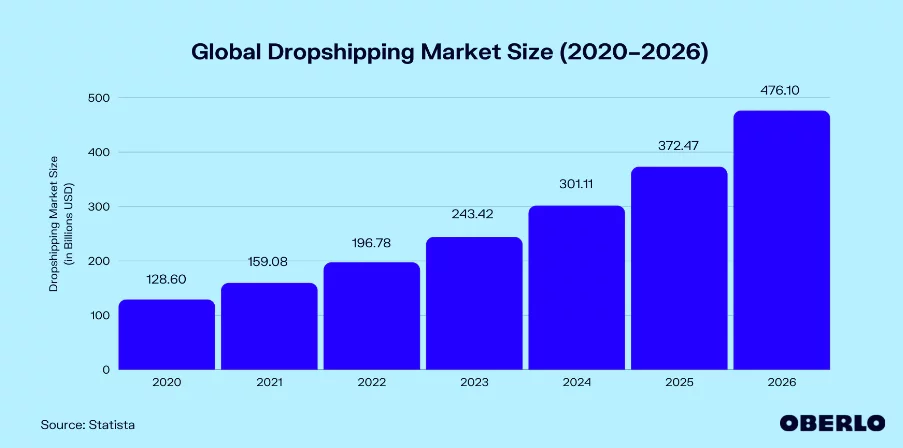
Image Source: https://www.oberlo.com/statistics/dropshipping-market
Between 2020 and 2026, the dropshipping market size is anticipated to experience a steady average annual growth rate of 24.39%, with the most significant surge projected for 2026, at an estimated increase of 27.82%. Leading up to 2025, the dropshipping market is expected to exhibit substantial growth, with an estimated rise of 23.7%.
How to dropship on Shopify?
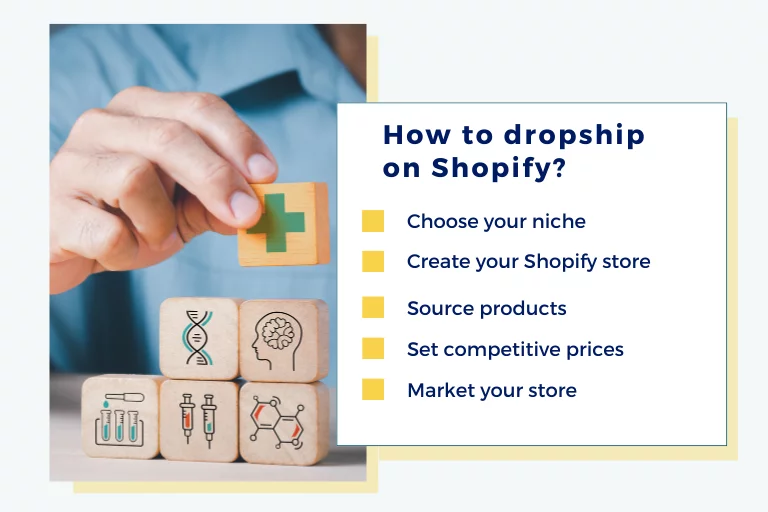
- Choose your niche: Research different product categories and identify a niche with demand and potential for profitability.
- Create your Shopify store: Sign up for a Shopify account and follow the easy setup process to build your online store. Customize your store’s design and layout to align with your brand.
- Source products: Find reliable suppliers who offer the products you want to sell. Use Shopify’s integrated Oberlo app to import products into your store easily.
- Set competitive prices: Determine the pricing for your products, considering the cost of goods and your target profit margin. Be sure to stay competitive within your niche.
- Market your store: Utilize various marketing channels like social media, email, and content marketing to drive traffic and generate sales.
Step-by-Step Guide
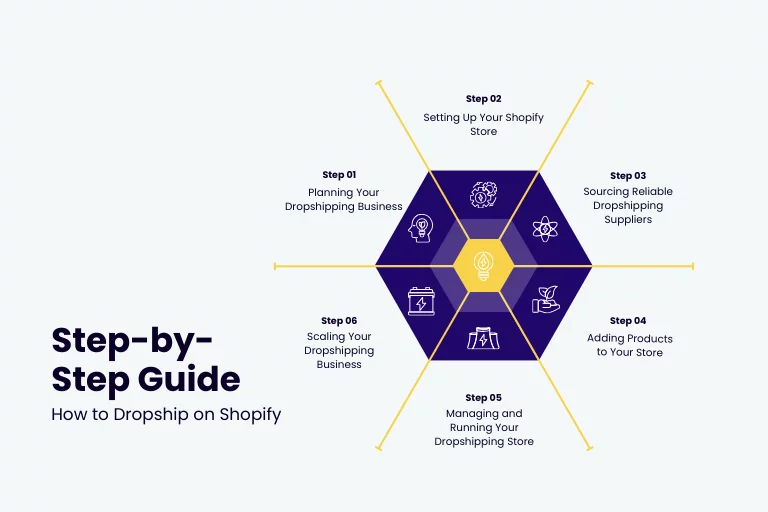
How to Dropship on Shopify: Step 1
Planning Your Dropshipping Business
Whether you’re a budding entrepreneur or an established business looking to expand, Shopify dropshipping can be a highly profitable venture. To ensure your success, proper planning is crucial. Here’s a step-by-step guide to help you get started.
Finding a lucrative dropshipping niche
Before you start your dropshipping business, it’s essential to identify a profitable niche. Research popular products and trends, and consider your interests and expertise. To increase your likelihood of success, research and select a niche with high demand and low competition. Then, thoroughly analyze your target audience’s needs, preferences, and purchasing behavior.
Defining your target audience for effective marketing
It is essential to identify the age, gender, location, and interests of the target audience for effective product marketing. Doing so allows you to tailor your marketing strategies and develop campaigns that cater to your intended audience. Conducting customer surveys and analyzing customer data can provide valuable insights into demographics and preferences.This information will enable you to refine your marketing strategies and deliver targeted messages that increase conversions.
After identifying your niche and target audience, you can source products, set up your Shopify store, and integrate with reliable dropshipping suppliers. Ensure a smooth shopping experience by optimizing your Shopify store’s appearance, usability, and mobile functionality.
When building your dropshipping business, prioritize excellent customer service, optimize product listings for search engines, and implement effective marketing strategies. Monitor your store’s performance and make data-driven improvements to drive sales and profitability.
By following these steps and staying committed to your dropshipping business, you can create a lucrative online venture and achieve long-term success on Shopify.
How to Dropship on Shopify: Step 2
Setting Up Your Shopify Store
To start dropshipping on Shopify, create a Shopify account by clicking “Get Started” on their website. You will be guided through setting up your store by providing basic information like your email address, password, and store name. Once you complete the registration, you can access the Shopify admin dashboard.
Customizing your store with themes and branding
After setting up your account, it’s time to give your store a personalized touch with themes and branding. Choose from various free and paid Shopify themes to create an attractive, easy-to-use storefront. Browse through the available themes, pick the one that aligns with your brand identity, and activate it for your store.
To further customize your store, you can upload your logo, customize the color scheme, and add branded images and text. This will help create a cohesive and unique brand experience for your customers.
Branding is essential for dropshipping as it helps create trust and recognition among your target audience. Use high-quality images, write compelling product descriptions, and maintain consistent branding across your store. By implementing this, your customers will feel more assured when making purchases from your store.
Additionally, consider adding relevant trust badges, customer reviews, and social proof to enhance trustworthiness and credibility.
Remember, a well-branded store goes beyond just appearance. Ensure your store is easy to navigate, offers a seamless checkout process, and provides excellent customer support.
Start your dropshipping journey on Shopify by building a strong brand presence with these steps.
How to Dropship on Shopify: Step 3
Sourcing Reliable Dropshipping Suppliers
When starting a dropshipping business on Shopify, sourcing reliable suppliers is essential to ensure smooth operations and customer satisfaction. Here are some steps to research and vet potential dropshipping suppliers:
- Identify your product niche: Determine what types of products you want to sell. This will help narrow down your search for suppliers specializing in those products.
- Search online: Use search engines and directories to find potential suppliers. Look for trustworthy websites, online marketplaces, and trade platforms that connect businesses with suppliers.
- Check supplier reputation: Read reviews and ratings from other dropshippers or businesses working with the suppliers. Pay attention to reliability, product quality, shipping times, and customer support.
- Contact the suppliers: Reach out to potential suppliers to ask questions about their products, shipping methods, return policies, and any other concerns you may have. This will help gauge their responsiveness and willingness to provide information.
- Order product samples: Before committing to a supplier, order samples of their products to assess their quality firsthand. This will give you confidence in the products you will offer your customers.
Read Dropshippers for Shopify: Select the Best [Expert Opinion]
Utilizing directories and networks to find trusted suppliers
In addition to online research, directories and networks can be valuable resources in finding trusted dropshipping suppliers. Here’s how you can utilize them:
- Trade directories: Explore reputable trade directories like Alibaba, SaleHoo, Wholesale2b, Modalyst, Doba, Inventory Source, Wholesale Central, or Worldwide Brands. Before engaging in any business transactions, it is essential to verify and vet suppliers from these directories, providing access to various suppliers in various industries.
- Dropshipping networks: Join dropshipping networks and platforms like DSers-AliExpress, Oberlo, or Spocket. These networks connect Shopify merchants with reliable suppliers, making finding products easier and streamlining the dropshipping process.
- Industry events: Attend trade shows, exhibitions, and industry conferences related to your product niche. These events provide an opportunity to connect with potential suppliers, inquire about their offerings, and evaluate them.
Remember, when choosing dropshipping suppliers, prioritize reliability, product quality, shipping efficiency, and good customer service. Thorough research and vetting will help ensure a successful and trustworthy partnership that benefits both your business and your customers.
How to Dropship on Shopify: Step 4
Adding Products to Your Store
If you consider dropshipping as a business model, you are on the right track to achieving financial independence. One key aspect of dropshipping is effectively adding products to your store. Here’s a step-by-step guide on how to do it on Shopify. Read Dropshipping Product Research: Tips to Find Hot Selling Products
Importing products from your suppliers
To begin, you need to establish relationships with reliable suppliers. Once you have found a supplier that meets your requirements, you can import their products into your Shopify store. Most suppliers provide product feed files that can be easily imported using Shopify’s built-in import tools. These tools allow you to add products, images, descriptions, and prices in bulk, saving you time and effort.
Editing product descriptions and pricing for optimal sales
After importing the products, optimizing their descriptions and pricing is important to attract potential customers. Make sure that your product descriptions are concise and persuasive and emphasize the distinctive features of each product. Remember to incorporate relevant keywords for improved search engine optimization.
Regarding pricing, consider the market competition and your profit margins. Set competitive yet profitable prices. Experiment with discounts and bundle deals to attract customers and boost sales. Read How to Price a Product on Shopify[Secret Tips]
Set up payment gateways and shipping options
To begin selling on your Shopify store, it’s important to first establish your payment gateways and shipping options. Shopify offers a broad selection of payment gateways, such as PayPal, Shopify Payments, Stripe, Authorize.net, WorldPay, Klarna, Opayo, and Verifone. Selecting the payment gateways that are popular and trusted by your target audience is vital.
Regarding shipping, you can use a third-party shipping app or Shopify’s own built-in shipping settings. Factors such as shipping costs, delivery times, and tracking options should all be considered when setting up your shipping options. Offering free or flat-rate shipping can attract more customers and increase sales.
Adding products to your store is necessary to create a successful dropshipping business. You can create a streamlined and efficient online store that attracts customers and drives sales by importing products from reliable suppliers, optimizing descriptions and pricing, and setting up payment gateways and shipping options.
How to Dropship on Shopify: Step 5
Managing and Running Your Dropshipping Store
Once your store is up and running, you must efficiently manage customer orders and provide excellent customer support. Here are some tips:
- Order fulfillment: When a customer orders, forward the details to your supplier for shipment. Keep track of order statuses and send shipment notifications to customers.
- Customer communication: Provide prompt customer support through email or chat to address inquiries and resolve issues.
- Returns and refunds: Have a clearly defined return policy and process in place. Handle returns and refunds efficiently to maintain customer satisfaction.
Staying on top of your financials
Managing your dropshipping store’s finances is essential for profitability. Consider the following:
- Pricing and profit margins: Set competitive prices for your products while maintaining a healthy profit margin. Consider product costs, shipping fees, and your desired profit margin.
- Shipping costs: Understand your supplier’s shipping costs and factor them into your product pricing. Offer shipping options to customers based on their location and preferences.
- Expenses and budgeting: Keep track of your business expenses, such as Shopify subscription fees, marketing costs, and advertising expenses. Set a budget for marketing and other business promotions.
- Analyze and optimize: Regularly review your financials and analyze sales performance. Adjust product pricing, shipping costs, and marketing strategies to maximize profitability.
You can effectively manage your Shopify dropshipping business by following these steps.
How to Dropship on Shopify: Step 6
Scaling Your Dropshipping Business
As an aspiring dropshipper, you have successfully set up your dropshipping store on Shopify and are ready to take it to the next level. Planning and executing a scale-up strategy is crucial for your business growth. Here’s a detailed guide to help you scale your dropshipping business on the Shopify platform.
Create a comprehensive marketing strategy
- Define your target audience: Customizing marketing strategies to target audiences is crucial.
- Optimize your website: Ensure your store is easy to navigate with attractive product descriptions and images to engage potential shoppers.
- Invest in digital marketing: Use social media ads, email marketing, SEO, and content marketing to attract store traffic.
- Engage with influencers: One effective way to boost brand awareness and promote your products is by collaborating with influencers in your niche. Implementing this approach may assist in expanding your audience and boosting your sales.
Leveraging customer feedback and market trends
- Collect customer feedback: Regularly solicit customer feedback to understand their needs, preferences, and pain points. By utilizing this feedback, you can enhance your products and elevate the overall customer experience.
- Monitor market trends: Stay up-to-date with the latest trends and adjust your product offerings to attract more customers.
- Stay competitive with pricing and offers: Continuously analyze your competitors’ pricing and offers to ensure you remain competitive.
Tips for scaling and growing your business
- Expand your product range: Consider adding complementary products to your store to increase customer options and encourage repeat purchases.
- Build strong customer relationships: Provide excellent customer service and build trust with your customers. Offer incentives such as loyalty programs or referral discounts to encourage repeat business.
- Optimize your operations: Streamline your order fulfillment, shipping, and customer support processes to ensure smooth operations as your business grows.
- Monitor and analyze your metrics: Track and analyze KPIs to identify improvement areas and measure scaling success.
Effectively scale and grow your Shopify dropshipping business by constantly adapting to the ever-changing market with these steps.
Is Dropshipping on Shopify worth it?
Yes, dropshipping on Shopify can be worth it for many entrepreneurs. With the right strategy and product selection, it can lead to a profitable online business. However, success depends on careful planning and execution.
Dropshipping on Shopify can be highly profitable for entrepreneurs who effectively manage their businesses. By leveraging the platform’s user-friendly interface and wide range of available tools, online retailers can streamline operations and focus on marketing their products.
According to the website Shop Theme Detector, the average dropshipping store has the potential to generate monthly earnings ranging from $1,000 to $2,000, requiring a weekly commitment of approximately 10 to 15 hours from the dropshipper. Nonetheless, some entrepreneurs can increase their earnings by managing multiple stores or intensifying their promotional efforts.
However, success in dropshipping often hinges on factors such as product selection, marketing strategies, and customer service, so careful planning and continuous optimization are vital to achieving profitability in this e-commerce model.
FAQs for How to Dropship on Shopify
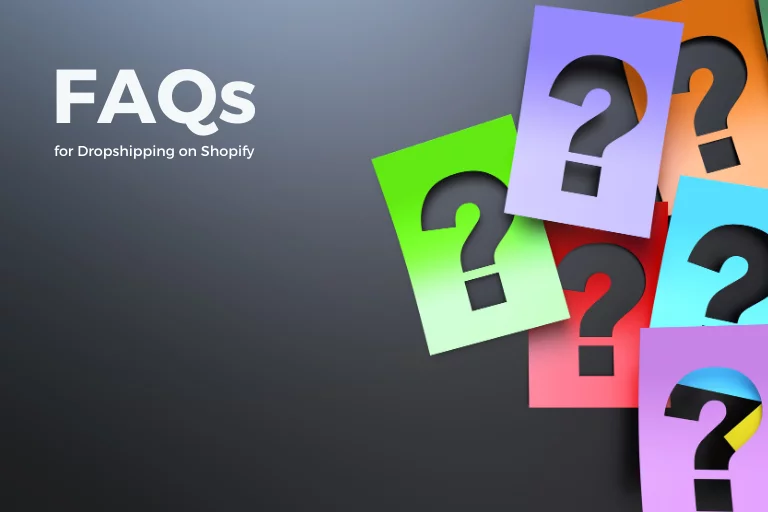
How do I start dropshipping on Shopify?
- Sign up for a Shopify account.
- Choose a niche or product category.
- Find reliable suppliers.
- Set up your online store.
- Customize your website.
- Add products and pricing.
- Implement marketing strategies.
- Launch your dropshipping business.
How does dropshipping work on Shopify?
- You create a Shopify dropshipping store.
- You select products from suppliers and list them in your Shopify store.
- Customers place orders on your website and pay you.
- You forward the order details to the supplier.
- The supplier delivers the products straight to the customer.
- You earn a profit margin from the price difference.
Is Shopify dropshipping difficult?
No, Shopify dropshipping is not difficult. With its user-friendly platform and resources, setting up an online store and managing dropshipping operations can be relatively straightforward for many entrepreneurs.
Can you dropship anything on Shopify?
Yes, but while you can dropship various products on Shopify, it’s vital to select items in demand and factor in shipping costs. Not all products are suitable for dropshipping, so prudent product selection is essential. Additionally, when dropshipping, it’s crucial to verify the legitimacy and reliability of suppliers to prevent potential copyright or trademark issues.
How does Shopify pay you for dropshipping?
- You receive payments from customers via Shopify Payments or other payment gateways.
- Profits are typically deposited into your bank account.
- Payment processing fees apply.
What is required to dropship?
- Reliable suppliers with dropshipping options.
- A Shopify store.
- Marketing and customer service skills.
What is the fastest way to dropship?
- Research popular, trending products.
- Optimize your website for conversions.
- Implement efficient marketing strategies.
Can I start dropshipping for free?
Yes, Shopify offers a 3-day free trial. However, ongoing costs include a monthly subscription and marketing expenses. Some minimal charges may apply for essential apps or services.
How to dropship for beginners?
- Research and choose a profitable niche.
- Create a user-friendly Shopify store.
- Develop a marketing plan.
- Source reliable suppliers.
- Focus on customer service and feedback.
- Continuously optimize your business strategies.
Conclusion
In the world of e-commerce, dropshipping on Shopify emerges as a shining opportunity for entrepreneurs seeking low-risk, high-reward ventures. With the global market poised to reach new heights and Shopify’s user-friendly platform at your fingertips, the potential for success is boundless.
But remember, success doesn’t come overnight. It’s nurtured through careful product selection, strategic marketing, and exceptional customer service. As the dropshipping landscape evolves, adaptability and optimization will be your allies.
Whether you’re starting or scaling your business, use dropshipping on Shopify. Dedication and the right approach can transform your aspirations into thriving online success. The future is bright – it’s time to shine on Shopify!









 What Is Shopify Dropshipping and How Does It Work?
What Is Shopify Dropshipping and How Does It Work? 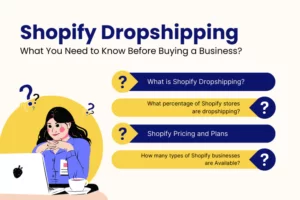 Shopify Dropshipping: What You Need to Know Before Buying a Business?
Shopify Dropshipping: What You Need to Know Before Buying a Business?  Guide to Finding Reliable Shopify Dropshipping Suppliers [100% Success]
Guide to Finding Reliable Shopify Dropshipping Suppliers [100% Success]  Payment Gateways for Shopify: Secure Transactions
Payment Gateways for Shopify: Secure Transactions